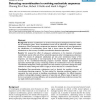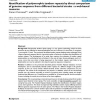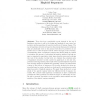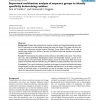1653 search results - page 84 / 331 » Adversarial Sequence Prediction |
BMCBI
2006
13 years 9 months ago
2006
Background: Genetic recombination can produce heterogeneous phylogenetic histories within a set of homologous genes. These recombination events can be obscured by subsequent resid...
BMCBI
2004
13 years 9 months ago
2004
Background: Polymorphic tandem repeat typing is a new generic technology which has been proved to be very efficient for bacterial pathogens such as B. anthracis, M. tuberculosis, ...
RECOMB
2002
Springer
14 years 10 months ago
2002
Springer
There has been considerable recent interest in the use of haplotype structure to aid in the design and analysis of case-control association studies searching for genetic predictors...
BMCBI
2007
13 years 9 months ago
2007
Background: Proteins that evolve from a common ancestor can change functionality over time, and it is important to be able identify residues that cause this change. In this paper ...
BMCBI
2007
13 years 9 months ago
2007
Background: Computational methods to predict transcription factor binding sites (TFBS) based on exhaustive algorithms are guaranteed to find the best patterns but are often limite...




